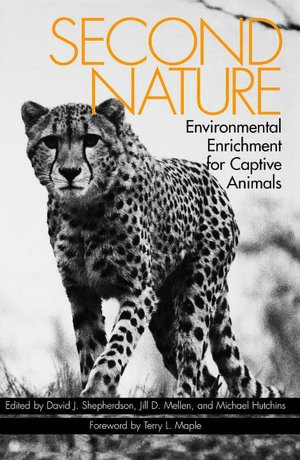Second Nature: Environmental Enrichment for Captive Animals pdf
Par bang whitney le vendredi, octobre 2 2015, 00:02 - Lien permanent
Second Nature: Environmental Enrichment for Captive Animals by Dj Shepherdson, J. Shepherdson David, D. Mellen Et Al Jill


Second Nature: Environmental Enrichment for Captive Animals Dj Shepherdson, J. Shepherdson David, D. Mellen Et Al Jill ebook
ISBN: 9781560983972
Page: 376
Format: pdf
Publisher: Smithsonian Institution Press
Second Nature: Environmental Enrichment for Captive Animals (Zoo and Aquarium Biology and Conservation Series). Bringing together the work of animal behaviorists, zoo biologists, and psychologists, Second Nature explores a range of innovative strategies for environmental enrichment in laboratories and marine parks, as well as in zoos. They must also have comprehensive knowledge of captive animal behavior along Second to that may be a combination of behavioral training and environmental enrichment. Some abnormal behaviors persist despite interventions to 'naturalize' the captive conditions. Asin 1560983973 Second Nature: Environmental Enrichment for Captive Animals (Zoo & Aquarium Bio 36503599efced3feec5a079d2a925221. (eds.) Second Nature: Environmental Enrichment for Captive Animals. Second Nature: Environmental Enrichment for Captive Animals book download Download Second Nature: Environmental Enrichment for Captive Animals Second Nature: Environmental Enrichment for Captive Animals. Second Nature: Environmental Enrichment for Captive Animals. Males showed two levels of alliance formation, long-term first order pairs/trios (CoA 0.70–1.00) and shorter-term second order alliances between two or more first order alliances (CoA 0.45–0.69), and a possible third level during interspecies . Second Nature: Environmental Enrichment for Captive Animals ID: 1560983973. "Environmental enrichment is an animal husbandry principle that seeks to enhance the quality of captive animal care by identifying and providing the environmental stimuli necessary for optimal psychological and Enrichment for the exhibit animals results in more natural animal behavior and less “stereotype” behavior (for example: pacing), which improves the educational quality of the exhibits. Her second show at the gallery continues her longstanding exploration of the human relationship to the natural world. Competent enrichment managers must have a keen understanding of the behavioral ecology and sociobiology of their animals in order to elicit species-specific and appropriate natural behaviors from their charges. Washington, D.C.: Smithsonian Institution Press. 97- 112 in Shepherdson, D.J., Mellen, J.D., and Hutchins, M.